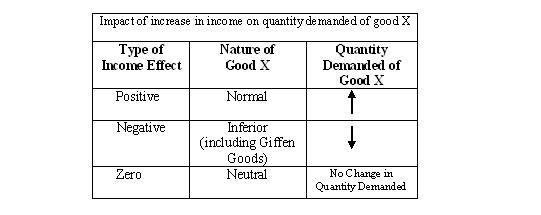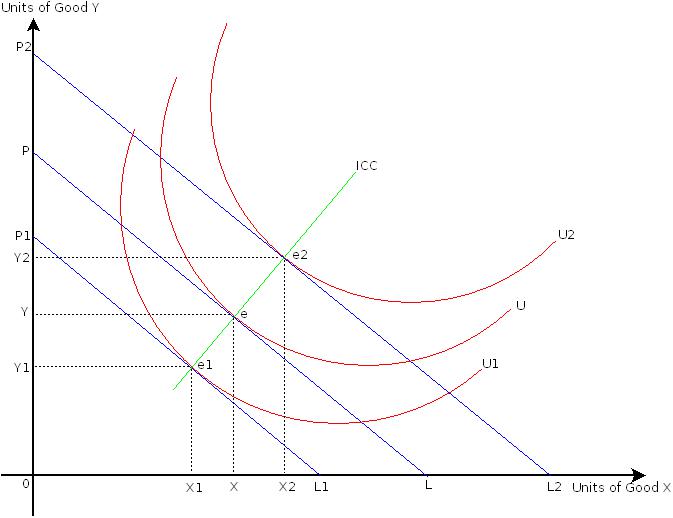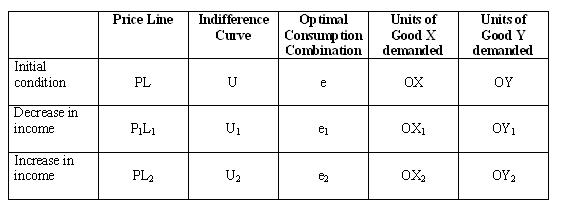INCOME EFFECT
MICROECONOMICS

|
INCOME EFFECT |

|
Introduction |
Similar to price, income is yet another factor determining buyers quantity purchased. Changes in the level of income lead the consumer to change her/his consumption, in order to maximize the utility of spendable income. Income rise on account of situations such as professional advancement, tax cuts, bonus, windfall financial gains etc. or fall in income caused by loss of job, imposition of new taxes, financial loss etc. influence consumer's consumption decisions. The analysis of income changes on consumption, therefore, is an important part of the theory of consumer's behavior.
In term of indifference curves analysis,just as the price effect, an income effect measures consumer's movement from one optimal consumption combination to another, on her/his indifference map, as a result of change in the income. Hick's income effect, discussed in this section, explains the logic and process of decision making by the consumer to arrive at optimal decision, as a response to income changes.
| Income Effect |
The income effect (IE) measures changes in consumer’s optimal consumption combinations caused by changes in her/his income and thereby changes in quantity purchased, prices of goods remaining unchanged. The consumer is better-off when optimal consumption combination is located on a higher indifference curve and vice versa.
Understand that like price effect, a consumer's responses to income changes also differ depending upon the nature of the good, viz. a normal good, inferior good or a neutral good. These are summarized in chart.1:

Thus, an income effect is positive in case of normal goods. There is direct relationship between income and quantity demanded. IE is negative in case of inferior goods (including Giffen goods) where we find inverse relationship between income and quantity demanded. Finally, IE is zero in case of neutral goods where consumer's quantity demanded is fixed.
Positive, negative and zero price effects are discussed with the help of indifference curves in the following subsections.
| Positive Income Effect |
The positive income effect measures changes in consumer's optimal consumption combination caused by changes in her/his income, prices of goods X and Y, which are normal goods, remaining unchanged.
Assumptions:
1. Consumer's preference for combinations of goods X and Y is given as represented by the indifference map.
2. Goods X and Y are normal goods.
3. Prices of goods X (Px) and Y (Py) are given and constant.
4. Initial income is given.
Figure.1 starts with the initial optimal consumption combination attained at point e at which OX units of good X and OY units of good Y are purchased.

Whenever income of the consumer change, the entire budget constraint shifts outwards or inwards. In other words it is always a parallel shift. With decrease in income the entire budget constraint shifts inwards and it is parallel to the initial price line. Similarly, when income increases then entire budget constraint shifts outwards and it is parallel to the initial price line.
When consumer's income decreases, the budget constraint moves inwards. This is shown by the budget constraint P1L1 in Figure.1. The optimal consumption is located at point e1 at which the consumer buys OX1 units of good X and OY1 units of good Y . Consumer’s total utility decreases as the optimal consumption combination is located on a lower indifference curve U1.
Similarly, when consumer's income increases, the budget constraint moves outwards. This is shown by budget constraint P2L2. The optimal consumption is now located at point e2, at which the consumer buys OX2 units of good X and OY2 units of good Y. Consumer’s total utility increases as the optimal consumption combination is now located on a higher indifference curve U2. Chart.2 presents a summary of Figure.1.

The curve obtained by joining optimal consumption combinations such as e1, e and e2 is called the income consumption curve (ICC). The ICC is a locus of a point that passes through optimal consumption combinations at various levels of income. The ICC in Figure.1 is rising upwards to the right. It shows that the consumer successively moves on a higher indifference curve and becomes better off, with increase in her/his income and she/he also increases consumption of of goods X and Y. Here income effect is positive for goods X as it is a normal good.



